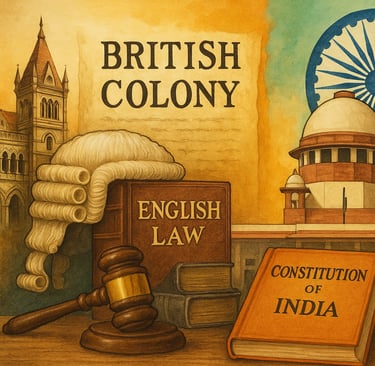How British Colonialism Shaped India's Current Legal System
This blog explores how British colonial rule profoundly influenced and shaped India's modern legal system. It traces the transformation from traditional and religious-based laws to a codified, common law system introduced by the British, including the establishment of courts, legal education, and foundational statutes like the Indian Penal Code. The post also reflects on the lasting impacts, both positive and critical, of this colonial legacy on India's contemporary legal framework. Ideal for readers interested in history, law, and post-colonial studies.
JUDICIAL INSIGHTS
DEV TRIVEDI
5/9/20253 min read


India’s legal system is among the world’s most complex and robust, rooted in centuries of evolution and layered with influences from various civilizations. However, the most defining and enduring impact on the legal framework as we know it today came during British colonial rule. Though colonialism came with its injustices, it also laid the groundwork for a modern legal infrastructure that continues to shape India’s governance, judiciary, and societal order.
The Pre-Colonial Legal Landscape
Before the British, India's legal systems were a diverse patchwork. Hindu and Islamic laws governed most civil matters such as marriage, inheritance, and caste, varying from region to region. Local rulers and village panchayats handled disputes informally and based on custom. There was no centralized, uniform legal code.
Enter the British: The East India Company Era
When the British East India Company began establishing control in the 18th century, they encountered legal diversity that was difficult to administer. They initially attempted to rule through existing customs and religious laws but soon found the need to standardize and centralize for efficient governance.
Key developments during this phase include:
1772: Warren Hastings introduced the Adalat system in Bengal, separating civil and criminal courts and formalizing judicial roles.
Religious laws codified: British judges began to rely on translated texts of Hindu and Islamic law, marking the beginning of legal codification in India.
The Foundation of Common Law in India
As British control expanded, they brought the English common law system—based on precedent, reason, and procedure—to the subcontinent. This was a turning point:
Laws based on reason, not religion: Criminal and contract laws began to move away from religious texts.
Legal precedent and hierarchy: The British introduced the doctrine of precedent (stare decisis), making judgments binding on lower courts, and creating an appellate system.
Judicial institutions: The establishment of the Supreme Court in Calcutta in 1774, and later High Courts in the Presidencies, brought structured adjudication.
The Codification of Laws
One of the most significant colonial legacies was the codification of laws, many of which still exist:
Indian Penal Code (IPC), 1860: Drafted by Thomas Babington Macaulay, this comprehensive criminal code remains largely in force today.
Evidence Act (1872), Contract Act (1872), and Civil Procedure Code (1908): These formed the backbone of civil and criminal justice and continue to be vital in Indian law.
Codification made the legal system more accessible, predictable, and consistent—critical for a diverse country like India.
Legal Education and the Profession
The British also introduced formal legal education and the concept of the legal profession:
Law schools and universities: Institutions like the University of Bombay and University of Calcutta began offering law degrees.
Legal professionals: The idea of the trained advocate and the Bar took shape, leading to a new class of lawyers who often played key roles in India’s independence movement—like Mahatma Gandhi and B.R. Ambedkar.
Post-Independence Continuity
At independence in 1947, India chose to retain much of the British legal framework, seeing it as modern, efficient, and adaptable. The Constitution of India, adopted in 1950, maintained:
Common law principles
Judicial independence
Doctrine of precedent
Adversarial system of justice
However, India also made key changes—embedding fundamental rights, socio-economic justice, and equality into its legal structure.
Critiques and Challenges
While the British legal legacy brought modernization, it also had downsides:
Alienation: The legal system often felt foreign and inaccessible to the common Indian.
Colonial intent: Many laws were designed to control rather than serve the population, leading to lingering authoritarian tendencies in some laws.
Over-centralization: Traditional and local systems of justice were marginalized, though efforts like Lok Adalats are trying to revive them.
Conclusion
British colonialism deeply shaped India’s legal system, laying the foundation for a codified, formal, and hierarchical legal structure that continues to serve the country today. While India has indigenized many aspects and introduced constitutional reforms, the imprint of British legal thought remains unmistakable. Understanding this legacy is essential not only for legal scholars but for anyone interested in how history informs governance in modern India.
LEGAL SPHERE Ltd © 2025
LEGAL SPHERE empowers individuals with knowledge and access to justice. We strive to protect rights, ensure fairness, and build a future rooted in legal integrity.
Reframe your inbox
Write your message below and stay connected with us!
We care about your data in our privacy policy.
